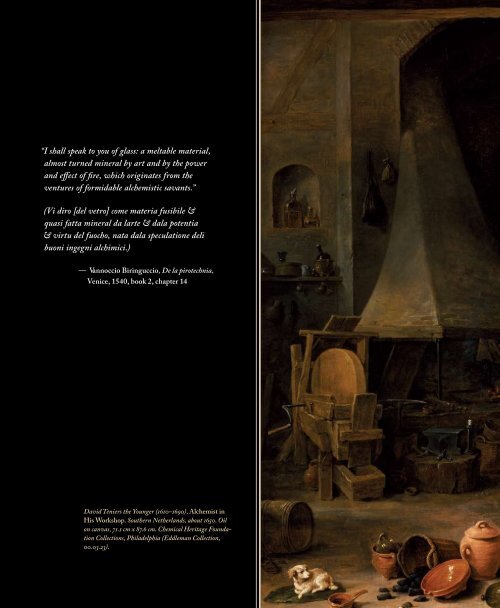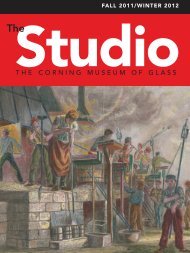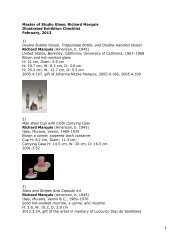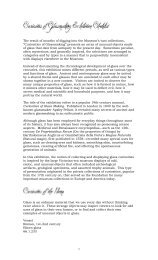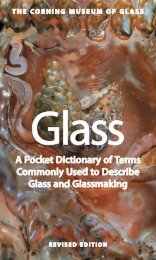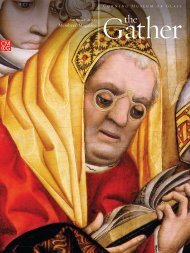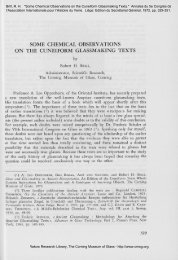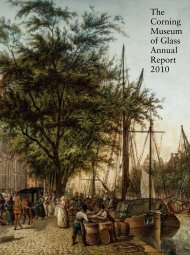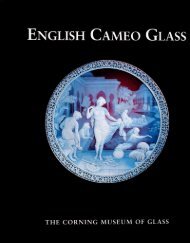Download PDF - Corning Museum of Glass
Download PDF - Corning Museum of Glass
Download PDF - Corning Museum of Glass
- TAGS
- download
- corning
- glass
- www.cmog.org
You also want an ePaper? Increase the reach of your titles
YUMPU automatically turns print PDFs into web optimized ePapers that Google loves.
“I shall speak to you <strong>of</strong> glass: a meltable material,<br />
almost turned mineral by art and by the power<br />
and effect <strong>of</strong> fire, which originates from the<br />
ventures <strong>of</strong> formidable alchemistic savants.”<br />
(Vi diro [del vetro] come materia fusibile &<br />
quasi fatta mineral da larte & dala potentia<br />
& virtu del fuocho, nata dala speculatione deli<br />
buoni ingegni alchimici.)<br />
— vannoccio biringuccio, De la pirotechnia,<br />
venice, 1540, book 2, chapter 14<br />
David Teniers the Younger (1610–1690), alchemist in<br />
his Workshop. Southern Netherlands, about 1650. Oil<br />
on canvas, 71.1 cm x 87.6 cm. Chemical Heritage Foundation<br />
Collections, Philadelphia (Eddleman Collection,<br />
00.03.23).
12<br />
1. Neri 1612, foreword: “molto si assomiglie<br />
ad ogni sorte di minerale, & mezzo<br />
minerale, quantunque sia un composto, et<br />
dall’Arte fatto.”<br />
2. Pharmacopoea Spagyricae, chap. 20,<br />
after Glauber 1689, p. 167.<br />
3. Gnilius 1711, p. 5: “mihi probabilius<br />
videtur. . . . Vitrum positum esse inter metalla<br />
& lapides, quippe de utrisque aliquid<br />
mutuo petit: v[idelicet] gr.[?] de metallis,<br />
quod sit liquabile: de Lapidibus, quod non<br />
sit ductile malleo, sed fragile &c.”<br />
4. Boyle 1673, pp. 70–71.<br />
5. Lemery 1716, pp. 576–577: “Vitrum,<br />
en François, Verre, est une matiere rendue<br />
transparente par la violence du feu, qui<br />
après en avoir chassé les parties grossieres,<br />
sulfureuses & mollasses, y a formé des<br />
pores droits en sorte que la lumiere puisse<br />
passer & repasser facilement au travers.”<br />
6. <strong>Glass</strong> does appear in nature, and it<br />
was sometimes used for crafts. The use<br />
<strong>of</strong> obsidian in Mesoamerica, for example,<br />
is well known. Less well known is the<br />
production <strong>of</strong> buttons from Proterobas<br />
(lamprophyre) in the Fichtelgebirge region<br />
in Germany during the 17th century.<br />
However, natural glasses were <strong>of</strong> no concern<br />
to vessel glassmakers in Renaissance<br />
and Baroque Europe.<br />
<strong>Glass</strong> <strong>of</strong> the Alchemists.<br />
I N T R O D U C T I O N<br />
W<br />
HAT IS GLASS? This seemingly simple question has no easy answer—not even<br />
in the present day, when scientists believe they have some understanding <strong>of</strong> the<br />
chemical and physical properties <strong>of</strong> glasses.<br />
The question must have been much more perplexing to people <strong>of</strong> earlier ages.<br />
<strong>Glass</strong> did not easily comply with scholarly attempts to classify materials. In 1612, the Florentine<br />
priest and alchemist Antonio Neri noted the close resemblance <strong>of</strong> glass to rocks and minerals, but<br />
he emphasized that glass is “a compound, and made by art.” 1 The German alchemist Johann Rudolf<br />
Glauber described the relationship between glass and metal in this way: “For all Sand or Flint, <strong>of</strong><br />
which <strong>Glass</strong> is made, is the Matrix or Mother <strong>of</strong> all Metals.” 2 As late as 1711, Johannes Gnilius, a<br />
Strasbourg scholar, seconded Vannoccio Biringuccio’s opinion that glass should be positioned between<br />
metals and stones because it displayed properties <strong>of</strong> both, being liquefiable like metals and<br />
brittle like stones. 3 Perhaps because the debate was leading nowhere, the Irish nobleman and scientist<br />
Robert Boyle considered certain characteristics <strong>of</strong> glass in 1673 and concluded that it allowed<br />
“ponderable parts <strong>of</strong> Flame . . . to pass through the pores.” 4 Nicolas Lemery may have had this comment<br />
in mind when he wrote in 1698 that “glass . . . is a material that is made transparent by the<br />
force <strong>of</strong> fire. After having chased away the coarse, sulfuric, and weak particles, [the fire] has formed<br />
straight pores <strong>of</strong> a sort that the light can easily pass back and forth through [the glass].” 5<br />
Knowledge.<br />
GLASS must have been attractive to alchemists for one reason in particular: unlike silver,<br />
wood, and clay, it was made, not found. 6 Man’s own creation was mixed from some simple<br />
raw materials and then fashioned in the fire into something entirely new—a substance that showed<br />
none <strong>of</strong> the characteristics <strong>of</strong> its source ingredients and that could not be turned back into them.<br />
For millenniums, the only way this experience had been understood was as an alchemical process, a<br />
transformation not unlike the presumed transmutation <strong>of</strong> base metals into precious metals. While<br />
such transmutations were <strong>of</strong>ten attempted and never accomplished (although practitioners frequently<br />
pretended otherwise), the successful results <strong>of</strong> glassmaking could be witnessed every day.<br />
Like any other manufacturing process, the production <strong>of</strong> glass requires trained and skilled<br />
workers (Fig. 1). <strong>Glass</strong>blowing demands considerable control and virtuosity, at least in part because<br />
hot glass can be worked only for a short time. More than many other crafts, however, glassmaking<br />
relies on knowledge. The slightest change in the composition <strong>of</strong> the raw materials or even a minor<br />
variation in furnace conditions can result in unwanted effects: the glass might suddenly change its<br />
color, accumulate various kinds <strong>of</strong> faults, or even crizzle (deteriorate) soon after it is made. Some<br />
glassmakers were content to draw upon the experience <strong>of</strong> the past, and they did well not to change<br />
any <strong>of</strong> their procedures. This was the case, for example, with the German glasshouses that produced<br />
green Waldglas (forest glass) <strong>of</strong> uniform quality for many centuries (Fig. 2). Yet if progress was desired,<br />
knowledge became the key ingredient. And the best source <strong>of</strong> expertise was to be found among<br />
the alchemists.
Fig. 1.<br />
Purification <strong>of</strong> ashes and the making<br />
<strong>of</strong> glass, illustration from Laboratory,<br />
or, School <strong>of</strong> Arts, 1738, pl. before<br />
p. 75. The upper half <strong>of</strong> the illustration<br />
shows equipment used to dissolve, boil,<br />
and calcine potash, “out <strong>of</strong> which may<br />
be made the finest <strong>Glass</strong> you can wish<br />
or desire.” The lower half presents<br />
glassmaking instruments, the two<br />
parts for a double-walled glass<br />
with enclosed gold-leaf decoration<br />
( Zwischengoldglas), and a kiln to<br />
fire the enamels on glass panes.<br />
Introduction<br />
13
14<br />
The term “alchemist” is about as precise a pr<strong>of</strong>essional characterization<br />
as “healer” would be for an otorhinolaryngologist.<br />
Alchemy was a form <strong>of</strong> worldview that involved amateurs as well<br />
as pr<strong>of</strong>essionals. The field <strong>of</strong> study for the alchemists encompassed<br />
the entire world in all its facets, natural and scientific as<br />
well as spiritual. Some researchers were specialists, such as the<br />
iatrochemists, who employed alchemical principles to create medicines.<br />
Those who devoted their attention to what today might<br />
be called the “materials sciences” were particularly successful.<br />
The breadth <strong>of</strong> the inquiry into the subject was matched by<br />
the body <strong>of</strong> literature that it produced. Modern accounts have<br />
<strong>of</strong>ten added to the confusion about alchemy, leaving readers with<br />
the impression that impenetrability was one <strong>of</strong> its chief features.<br />
Some much-needed clarification is provided in the introductory<br />
chapters <strong>of</strong> this catalog by Pamela H. Smith and William R.<br />
Newman, two <strong>of</strong> the best-known experts in the field. Their chapters<br />
amount to a translation <strong>of</strong> alchemical reasoning into modernday<br />
terms. Smith (pp. 23–33) provides an overview <strong>of</strong> the extent<br />
<strong>of</strong> alchemy and focuses on one <strong>of</strong> its chief aims, the imitation <strong>of</strong><br />
<strong>Glass</strong> <strong>of</strong> the Alchemists.<br />
Fig. 2.<br />
“Unbreakable” Waldglas beaker. Germany, dated 1656. H. 13<br />
cm. The <strong>Corning</strong> <strong>Museum</strong> <strong>of</strong> <strong>Glass</strong> (79.3.617, gift <strong>of</strong> The Ruth<br />
Bryan Strauss Memorial Foundation). The beaker bears the<br />
diamond-point engraved and gilded inscription “Trinch mich<br />
auss vnnd würff mich Nider / heb mich auff vnnd vill mich<br />
wider 1656” (Empty me and throw me down; pick me up and<br />
fill me again, 1656).<br />
Fig. 3.<br />
Three cristallo goblets. Venice, about 1600. H. (tallest) 17.8 cm.<br />
The <strong>Corning</strong> <strong>Museum</strong> <strong>of</strong> <strong>Glass</strong> (61.3.135, 60.3.17, 70.3.8).<br />
nature. This goal was shared by artists, and it gave rise to innumerable<br />
points <strong>of</strong> contact. Smith notes that alchemy, which was concerned<br />
with both practical and scientific considerations, bridged<br />
the divide between the scholar and the artisan. Newman (pp. 35–<br />
47) states that alchemists regarded themselves as “searchers into<br />
Nature’s secrets.” They were “chymists,” the true precursors <strong>of</strong> modern<br />
chemists, and it was in the context <strong>of</strong> “chymistry” that the<br />
term “research” was first employed. Newman reports on the scientific<br />
reasoning <strong>of</strong> alchemists in the 17 th century—including such<br />
concepts as the corpuscular theory and the organic growth <strong>of</strong> metals<br />
in the earth—and their attempts to prove their beliefs in the<br />
laboratory.<br />
Recently discovered sketches in the notebook <strong>of</strong> a 16th-century<br />
alchemist perfectly illustrate the ideas <strong>of</strong> alchemy and their<br />
usefulness to humankind (pp. 49–61). The fact that this alchemist,<br />
Antonio Neri, was also the author <strong>of</strong> L’Arte vetraria, the single<br />
most influential glassmaking manual <strong>of</strong> all time, makes these<br />
drawings even more intriguing. We are very grateful to Paul Engle,<br />
their discoverer, for allowing us to include selected drawings from<br />
this manuscript in the present volume.<br />
The number <strong>of</strong> alchemists who followed Neri’s example and<br />
gained substantial expertise in glassmaking was probably small.<br />
But those few practitioners possessed the necessary skills for success.<br />
They had a laboratory at their disposal, which permitted<br />
them to conduct experiments on a small and thus affordable scale.<br />
They were experienced in the treatment <strong>of</strong> raw materials, and they<br />
proceeded to study the effects on glass <strong>of</strong> a wide range <strong>of</strong> elements.<br />
They formed networks by which they communicated their findings<br />
to other experts, and they were able to access publications<br />
on the subjects that interested them. None <strong>of</strong> these benefits was<br />
easily available to general glassmakers.
7. Zecchin 1987, pp. 237–241.<br />
8. Cf. Kerssenbrock-Krosigk forthcoming.<br />
Introduction<br />
Innovation.<br />
IT IS one thing to claim that improvements in glass were brought about by some interactions<br />
between alchemists and glassmakers, but quite another to present pro<strong>of</strong>. Because <strong>of</strong> a dearth <strong>of</strong><br />
surviving documents, we know very little about the circumstances surrounding the invention <strong>of</strong> new<br />
types <strong>of</strong> glass. One <strong>of</strong> the most important such inventions is Venetian cristallo, which is credited to<br />
Angelo Barovier on the glassmaking island <strong>of</strong> Murano in 1453. 7 Not much has been recorded about<br />
this event. We do not know, for example, how the development <strong>of</strong> cristallo is related to the emergence<br />
<strong>of</strong> colorless glass in the 13th and 14th centuries, and the meager sources do not tell us if, and<br />
to what extent, alchemy informed Barovier’s achievements. 8 We do not even have vessels that can<br />
be unmistakably attributed to his time or workshop, but we do know that cristallo was at the center<br />
<strong>of</strong> Venice’s success in glassmaking for the next couple <strong>of</strong> centuries. It is most typically identified<br />
with paper-thin wineglasses <strong>of</strong> the late 16th and early 17th centuries (Fig. 3), and it is supplemented<br />
by such colored and color-patterned glasses as calcedonio and filigrana.<br />
15
16<br />
9. Beyond Venice 2004.<br />
10. According to Rudolf Distelberger<br />
(Kunst des Steinschnitts 2002, p. 76), the<br />
Vicenza goldsmith Valerio Belli (about<br />
1468–1546) was the first Renaissance artist<br />
to whom rock crystal engraving can be attributed.<br />
11. Important general histories <strong>of</strong> glass,<br />
such as Schmidt 1922, tend to concentrate<br />
on shapes and decoration rather than on<br />
the material; see also Tait 1991, pp. 179–184.<br />
<strong>Glass</strong> <strong>of</strong> the Alchemists.<br />
Until the early 18th century, Venice was the undisputed worldwide leader in glassmaking. Factors<br />
such as its harbor, which afforded easy access to high-quality raw materials and excellent conditions<br />
for exporting finished products, and the skill and inventiveness <strong>of</strong> its glassblowers helped to<br />
keep the city at the forefront <strong>of</strong> glassmaking developments. <strong>Glass</strong>houses on Murano were relatively<br />
isolated, and, with few exceptions, the Venetian city-state tried to prevent their recipes and techniques<br />
from being dispersed to competitors in other regions. Its efforts were unsuccessful, however,<br />
and a recent exhibition at The <strong>Corning</strong> <strong>Museum</strong> <strong>of</strong> <strong>Glass</strong> provided ample evidence <strong>of</strong> the achievements<br />
<strong>of</strong> glasshouses that worked à la façon de Venise (in the style <strong>of</strong> Venice). 9<br />
Outside Venice, some other new paths in glassmaking were made during the 17th century. Goblets<br />
with tall composite stems (13) were to become fashionable during the late 17th and early 18th<br />
centuries. The delicacy <strong>of</strong> Venetian glass was gradually abandoned in favor <strong>of</strong> rich Baroque ornament<br />
(14). In addition, engraving was introduced. This technique had been used to decorate rock<br />
crystal since its introduction in Italy in the late 15th or early 16th century, 10 but it seems not to have<br />
occurred to artists to apply it to glass until the late 16th century, perhaps because this relatively<br />
inexpensive material did not appear to be worth the effort required by engraving. While a Venetian<br />
tazza could be fashioned by a master glassblower in minutes, the fine engraving <strong>of</strong> an elaborate scene<br />
on a goblet could consume weeks.<br />
Nevertheless, the 17th century became a period noted for the engraving <strong>of</strong> glass vessels in central<br />
Europe. The <strong>Corning</strong> <strong>Museum</strong> <strong>of</strong> <strong>Glass</strong> owns a rare early example (11). To be successful, engraving<br />
on glass required both a fairly thick vessel wall and a purer batch that would produce a colorless<br />
glass with few bubbles. Several generations <strong>of</strong> masters in Nuremberg created the best engraved glass<br />
<strong>of</strong> this period by applying a very shallow but exquisite relief on glass <strong>of</strong> fine quality (15 and 16). But<br />
in order to fully emulate rock crystal, one major step was still required: making a glass so colorless,<br />
clear, and transparent that it could be carved in deep relief.<br />
This catalog, as well as the exhibition it documents, focuses on this major advance in the history<br />
<strong>of</strong> glassmaking. Unlike the earlier technological innovations in glass made in Venice, this development<br />
did not take place in a single city or region. Instead, it was spread among many glasshouses,<br />
from Dublin in the west to Naliboki, Poland, in the east, and from Nøstetangen, Norway, in the<br />
north to Munich in the south. The period during which this change occurred is as broad as its geography.<br />
While its beginnings can be traced back to the early 1670s, some regions started much<br />
later, such as the Nøstetangen glasshouse in the mid-18th century (56–58). The principal achievements<br />
were recorded during the last quarter <strong>of</strong> the 17th century, predominantly in England, where<br />
George Ravenscr<strong>of</strong>t received a patent for the making <strong>of</strong> lead crystal in 1674; in Brandenburg, where<br />
the alchemist Johann Kunckel developed crystal and gold ruby glass in the late 1670s; in southern<br />
Bohemia, where the counts <strong>of</strong> Buquoy maintained a crystal glassworks, and where the glass production<br />
<strong>of</strong> Michael Müller in his Helmbach glasshouse was highly regarded; and at several locations<br />
in central Germany.<br />
Some details concerning these achievements have long been known, but until recently they were<br />
treated as isolated incidents. It was assumed that the invention <strong>of</strong> Baroque crystal was somehow<br />
“in the air,” and that skilled glassmakers in various parts <strong>of</strong> Europe independently accepted this<br />
challenge. 11 The influence <strong>of</strong> alchemy was well established in one instance: Kunckel’s development<br />
<strong>of</strong> gold ruby in Brandenburg (pp. 123–137), but no further interactions <strong>of</strong> this kind were suspected.<br />
The central argument <strong>of</strong> this book is that many, if not all, <strong>of</strong> the decisive improvements in glassmaking<br />
during the last third <strong>of</strong> the 17th century were informed by alchemical knowledge. According<br />
to Werner Loibl, the foremost expert in the history <strong>of</strong> 17th- and 18th-century glasshouses in Germany,<br />
this knowledge may have been principally rooted in the work <strong>of</strong> a single individual: the alchemist<br />
and pharmacist Johann Rudolf Glauber (1604–1670).
12. Quoted after Merton 1938, p. 607.<br />
13. Glauber was a rare exception to<br />
this rule. He refused patronage and lived<br />
entirely on the sale <strong>of</strong> his products.<br />
Introduction<br />
Dissemination.<br />
GLAUBER, who has been called the best practical chemist <strong>of</strong> his time, is also regarded as<br />
one <strong>of</strong> the founders <strong>of</strong> industrial chemistry (Ahonen 1981, p. 423). He is best known for his<br />
innovative preparations <strong>of</strong> acids and salts, his improvements in the technical setup <strong>of</strong> laboratories,<br />
and his studies <strong>of</strong> fermentation, especially in the production <strong>of</strong> wine. As far as we can tell, glass for<br />
decorative or household use was <strong>of</strong> no concern to him, although he apparently used the facilities<br />
<strong>of</strong> the Rozengracht glasshouse in Amsterdam for some <strong>of</strong> his experiments (10). However, he had<br />
a keen interest in the alchemical implications <strong>of</strong> this material. He developed the process <strong>of</strong> coloring<br />
glass with a gold-tin solution, purple <strong>of</strong> Cassius, not to produce vessels (as Johann Kunckel later<br />
did) but because he saw a link between this process and the transmutation <strong>of</strong> metals (pp. 27 and<br />
64). Glauber believed that metals showed their true colors only when they were melted into glass,<br />
and he hoped that, by extracting these colors, he would move closer to revealing the secret <strong>of</strong> the<br />
philosophers’ stone. This effort was unsuccessful, but his experiments yielded a welcome benefit: the<br />
qualitative analysis <strong>of</strong> metal ores. As Robert Boyle reported to The Royal Society, “This was only by<br />
mixing some glass with the mineral, and that thereby the metal predominant in the ore is discovered,”<br />
because each metal produces its own distinct color in glass. 12<br />
Perhaps <strong>of</strong> greater importance to the history <strong>of</strong> glassmaking than Glauber’s experiments with<br />
glass were his preparations <strong>of</strong> substances that were to become core raw materials <strong>of</strong> Baroque crystal,<br />
such as tartar, saltpeter (Fig. 4), and potash. His process <strong>of</strong> extracting tartar from wine lees is particularly<br />
revealing in regard to his economical manner <strong>of</strong> thinking, in that the process yields not<br />
only tartar but also vinegar, alcohol, and potash, making the enterprise pr<strong>of</strong>itable (Glauber 1654).<br />
Unlike other alchemists, Glauber apparently did not attempt to communicate with other important<br />
figures in his field. Nevertheless, his work exerted considerable influence, especially in his<br />
many writings and in the work <strong>of</strong> his assistants and followers, who applied Glauber’s knowledge<br />
to other fields, such as the making <strong>of</strong> glass.<br />
The advances <strong>of</strong> alchemists are not easy to trace because many <strong>of</strong> the movements <strong>of</strong> these researchers<br />
are undocumented and must therefore be conjectured. Most <strong>of</strong> the alchemists depended<br />
upon patrons for support, and thus they <strong>of</strong>ten had to abandon half-finished projects and move on<br />
when their benefactors died, lost interest in their experiments, or simply stopped making payments. 13<br />
Three contributions to this catalog attempt to follow these relocations in central Europe. Werner<br />
Loibl provides an account <strong>of</strong> the network that can be detected between the main protagonists (pp.<br />
63–73), which extended far beyond the borders <strong>of</strong> the Holy Roman Empire into Scandinavia and<br />
even as far as China (see also 115–117). Loibl considers Johann Daniel Crafft (1624–1697), Glauber’s<br />
assistant for a decade, to have been the key intermediary in the dissemination <strong>of</strong> Glauber’s teachings.<br />
In maintaining close contacts with many <strong>of</strong> the leading alchemists /technologists <strong>of</strong> his time,<br />
he fulfilled a role that his master had avoided. Crafft apparently produced no publications <strong>of</strong> his<br />
own, and this makes it hard for researchers to study his work. Fortunately, one <strong>of</strong> his counterparts,<br />
the alchemist and polymath Johann Joachim Becher (1635–1682), was a prolific writer. Martin Mádl,<br />
an expert on the arts <strong>of</strong> the Baroque era, <strong>of</strong>fers a lively portrait <strong>of</strong> the glass-related technological<br />
activities and beliefs <strong>of</strong> Becher’s time (pp. 97–105). Crafft’s and Becher’s work in various central<br />
European regions, including Austria and Bohemia, has been researched, and Olga Drahotová, the<br />
grande dame <strong>of</strong> the history <strong>of</strong> Baroque glass in Bohemia, provides an overview <strong>of</strong> early Baroque<br />
Bohemian glassworks, including some important earlier Czech research that is here published for<br />
the first time in English (pp. 75–95).<br />
These contributions afford us a vivid impression <strong>of</strong> the considerable number <strong>of</strong> glasshouses in<br />
Germany and Bohemia that attempted—some more successfully than others—to produce glass<br />
17
18<br />
<strong>Glass</strong> <strong>of</strong> the Alchemists.<br />
Fig. 4.<br />
Furnace for transformation <strong>of</strong> wood into saltpeter, from Glauber 1689, fig. 13 after p. 188. Chemical Heritage Foundation<br />
Collections, Philadelphia (Roy G. Neville Historical Chemical Library). The furnace, which “must be like a <strong>Glass</strong>maker’s<br />
Furnace,” is filled with layers <strong>of</strong> wood and limestone, and kindled. The resulting smoke is forced through a long pipe,<br />
and it condenses into an acid “juice.” By mixing this with the lime and ashes from the furnace, a solution <strong>of</strong> caustic<br />
potash is prepared. In a lengthy process <strong>of</strong> putrefaction, the solution is subsequently transformed into saltpeter.
14. Pamela Smith has led the way in<br />
delving into this subject. See Smith 1994<br />
and 2004.<br />
Introduction<br />
<strong>of</strong> the highest quality. Only a few <strong>of</strong> them, such as the glassworks in Potsdam and Michael Müller’s<br />
glasshouse in southern Bohemia, left written records and /or examples <strong>of</strong> their production for historians<br />
to examine. Other factories may have been equally productive, but they sank into oblivion.<br />
The network <strong>of</strong> alchemists engaged in glass research was not confined to the Continent. Glauber’s<br />
teachings, and some substantial practical knowledge from Italian glassmakers who had worked<br />
in the Netherlands, were carried across the Channel and influenced George Ravenscr<strong>of</strong>t’s famous<br />
production <strong>of</strong> flint glass in England in 1674. Colin Brain, who may be described as an amateur—in<br />
the best sense <strong>of</strong> the word—in the history <strong>of</strong> British glass, has scrutinized all <strong>of</strong> these events, and he<br />
presents a fresh view <strong>of</strong> the subject, complete with hitherto overlooked details (pp. 107–121). His<br />
conclusion that lead crystal was not an exclusively English invention but was instead introduced<br />
from the Netherlands is bound to stir some emotions and possibly resistance. Perhaps more importantly,<br />
Brain explains that alchemists and glassmakers had parallel interests, in that they worked<br />
with many <strong>of</strong> the same raw materials and techniques, but not necessarily with the same goals.<br />
While glassmakers found in lead crystal a perfect batch for clear, faultless glass, alchemists were<br />
attracted to glasses with a very high lead content, which they named vitrum saturni, because they<br />
hoped that this material would serve as a flux to separate base and pure metals (p. 120).<br />
Some alchemists had glassmaking skills, and quite a few glassmakers probably possessed alchemical<br />
knowledge. Rare, however, was the individual who engaged in both occupations with an<br />
equally high level <strong>of</strong> expertise. One such gifted practitioner was Johann Kunckel (1637?–1703). He<br />
did alchemical research for about 10 years in Saxony, then moved in 1678 to Brandenburg, where he<br />
concentrated on glassmaking. Kunckel dramatically increased the usefulness <strong>of</strong> Neri’s L’Arte vetraria<br />
by providing a carefully considered commentary <strong>of</strong> his own, and he created some <strong>of</strong> the most accomplished<br />
crystal on the Continent at that time (pp. 123–137). His best-known achievement,<br />
however, was the production <strong>of</strong> gold ruby vessels (cf. 72–80). These precious objects, in which the<br />
addition <strong>of</strong> gold to the batch turned the glass a deep red color, are the most striking embodiments<br />
<strong>of</strong> the interaction <strong>of</strong> glass and alchemy.<br />
Prospects.<br />
GL ASS <strong>of</strong> the Alchemists does not claim to present conclusive arguments. Work on this subject<br />
is still in the early stages, and all <strong>of</strong> its aspects are open to further discussion. The contributions<br />
to this catalog occasionally reflect on the same episodes, such as that concerning the mysterious<br />
alchemist Pietro del Bono and his possible influence on glassmaking in southern Bohemia,<br />
in order to assess existing accounts from different viewpoints. General readers may find some insights<br />
into the processes, puzzlements, and pitfalls <strong>of</strong> historical research, while scholars in the field<br />
are encouraged to dig deeper and to come up with new evidence.<br />
Beyond the narrow subject <strong>of</strong> Baroque crystal, there is a wealth <strong>of</strong> information to be discovered<br />
on the achievements <strong>of</strong> alchemy, or “chymistry,” in other materials and periods. 14 A glimpse <strong>of</strong> this<br />
is provided here with the discussion <strong>of</strong> the work <strong>of</strong> Johann Friedrich Böttger (1682–1719), an alchemist<br />
and the co-inventor <strong>of</strong> German hard porcelain (112–114).<br />
Moreover, there is a striking link between alchemy and modern-day science. Our electronic age<br />
has not made the materials sciences obsolete. While the appreciation <strong>of</strong> pristine household items<br />
may have faded, high-tech innovations are pursued in almost every facet <strong>of</strong> human activity—from<br />
the carbon-nanotube tennis racket for an occasional weekend match to more and more sophisticated<br />
materials for increasing safety and fuel efficiency in an age <strong>of</strong> global travel. In all <strong>of</strong> this, glass<br />
continues to play a crucial role. It may represent an old tradition (Fig. 5), but its potential is far from<br />
being exhausted. To demonstrate this point, Robert H. Brill and six other scientists, eminent re-<br />
19
20<br />
<strong>Glass</strong> <strong>of</strong> the Alchemists.<br />
Fig. 5.<br />
<strong>Glass</strong>making instruments, from Barrow 1735, v. 2, pl. III. Most <strong>of</strong> the instruments shown are still used in the modern-day<br />
blowing <strong>of</strong> glass: (A) blowpipe; (B) pontil rod; (C) “scissors” (straight shears); (D) “sheers” ( jacks); (E) “which the Italians call ponteglo,<br />
passago, procello, spiei, and also borsello” (pincers); (F) “great ladle [to] take out the metal <strong>of</strong> the great pot . . . and put it<br />
into the little ones for the workmen”; (G) “little ladle . . . for skimming the metal”; (H) “great and little shovels”; (I) “hooked<br />
fork . . . to stir the matter in the pots”; (K) “rake . . . to stir the matter, as also to move about the frit in the first oven”;<br />
(L) “the Instrument . . . for making champer-pots”; (M) “fork . . . to carry the glass-works into the upper oven to cool them”;<br />
and (N) “great ladle . . . to take <strong>of</strong>f the alcali salt from the kettles.” This plate follows an illustration <strong>of</strong> instruments that forms<br />
part <strong>of</strong> various editions <strong>of</strong> Neri’s L’Arte vetraria (e.g., Kunckel 1679, pl. 5 after p. 334).
searchers in their fields, <strong>of</strong>fer some insights into present-day<br />
glassmaking developments (pp. 303–317). <strong>Glass</strong> technology has<br />
completely changed since the days <strong>of</strong> the Baroque alchemists, and<br />
yet there are connections. The focus, which was then on imitating<br />
precious stones, is now on adapting the material to technical<br />
needs. Zero-expansion glass for telescope mirrors (pp. 304–305),<br />
the emergence <strong>of</strong> liquid crystal display screens (pp. 306–307), the<br />
vitrification <strong>of</strong> nuclear waste (pp. 307–309), and nanotechnology<br />
(pp. 311–313) are entirely modern phenomena, but the approach to<br />
these tasks—finding the appropriate batch and fusing the glass<br />
in a manner that best serves the required purpose—is not altogether<br />
different. In addition, some modern uses <strong>of</strong> glass have<br />
early roots. The development <strong>of</strong> optics and telescope lenses, in<br />
particular, provided a big incentive for improvements in glass<br />
following the Renaissance, and the vitrification <strong>of</strong> nuclear waste<br />
employs a property <strong>of</strong> glass that was highly cherished by alchemists:<br />
serving as a flux for the widest range <strong>of</strong> elements. The attempt<br />
to eliminate arsenic from liquid crystal display screens<br />
reminds us that this fining agent was introduced in the late 17th<br />
century, and it has been used in glassmaking ever since. Putting<br />
the theoretical strength <strong>of</strong> glass (which is much higher than commonly<br />
thought) into practice (pp. 309–311) would surely have<br />
Introduction<br />
21<br />
captured the keen interest <strong>of</strong> any alchemist. Seventeenth- and<br />
18th-century researchers did not have a thermal-shock-resistant<br />
glass, which, in the form <strong>of</strong> borosilicate glass, is today a common<br />
feature in every kitchen.<br />
Is there really anything that we moderns have still to learn<br />
from alchemy? To be sure, today’s theory <strong>of</strong> chemistry has little<br />
to do with alchemical concepts, which, on the whole, have become<br />
obsolete. In the epilogue to this volume (pp. 313–317), Adrian C.<br />
Wright shows just how much our current understanding <strong>of</strong> glass<br />
has changed. Nevertheless, the willingness <strong>of</strong> intrepid alchemists<br />
to venture into completely unknown realms <strong>of</strong> research, as well<br />
as their ability to turn many <strong>of</strong> their findings into pr<strong>of</strong>itable enterprises,<br />
deserves our admiration. In the end, these remain the qualities<br />
that distinguish successful scientists. The distance between<br />
them and their predecessors is not so vast. And the question behind<br />
the inquiries <strong>of</strong> researchers old and new—what is glass?—<br />
continues to fascinate.<br />
Dedo von Kerssenbrock-Krosigk<br />
Curator <strong>of</strong> European <strong>Glass</strong><br />
The <strong>Corning</strong> <strong>Museum</strong> <strong>of</strong> <strong>Glass</strong>


